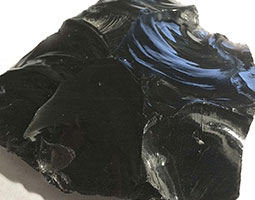Description

Obsidian is an igneous rock that forms when molten rock ‘material cools so rapidly that atoms are unable to arrange themselves into a crystalline structure. Obsidian is usually an extrusive rock - one that solidifies above Earth's surface. However, it can form in a variety of cooling environments:
- along the edges of a lava flow (extrusive)
- along the edges of a volcanic dome (extrusive)
- around the edges of a sill or a dike (intrusive)
- where lava contacts water (extrusive)
- where lava cools while airborne (extrusive)
Uses
The manufacture of obsidian tools by humans dates back to the Stone Age. At some locations, tonnes of obsidian flakes reveal the presence of ancient ‘factories’. Some of these sites have enough waste debris to suggest that many people laboured there for decades producing a variety of obsidian objects. Making arrowheads, spear points, knife blades, and scrapers from obsidian, chert, or flint might have been the world's first'manufacturing industry'.
Obsidian can be used to produce a cutting edge that is thinner and sharper than the best surgical steel. Today, thin blades of obsidian are placed in surgical scalpels used for some of the most precise surgery.
Source: http://geology.com/rocks/obsidian.shtml